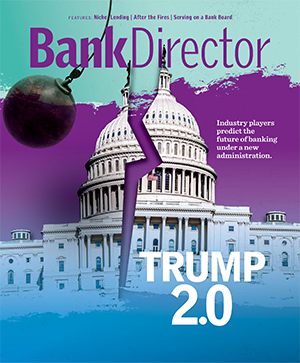
What Makes a Banking Leader

B is for balance sheet: Today’s bank leaders must understand the risks inherent in the current interest rate environment, whether due to potential funding mismatches or the risks from declining securities values in a rising rate environment.
A stands for asset quality: Bank leaders must remain vigilant regarding credit quality. There’s still no quicker way for a bank to falter than to suffer from a spate of bad loans. Regulators continue to focus on credit culture, policies and procedures as well.
N is for non-interest income: Everyone wants more, but how do we actually grow revenues? Increasing fees on customers always carries some potential fallout. And building lines of business such as wealth management, insurance or other products involves a significant up-front investment and a long-term return. There are few easy answers here.
K represents capital: As everyone knows, this is the most critical ingredient that banks need today to survive and drive growth, whether organic or transactional. A lack of ample capital not only constrains strategic plans, but too often invites a call from your regulator.
The L stands for leadership: While great leadership remains an obvious prerequisite for success, the demands on bank leaders today are more strenuous and complex than at any time since the Great Depression. Many bank boards struggle with the challenges of succession and developing that vital next generation. In addition, the mantle of leadership should extend much further into the organization than just the CEO’s office or C-Suite executives for an organization to truly succeed. While the CEO sets the tone, everyone should lead by example in their daily interactions with customers and colleagues.
E stands for emotional intelligence: This is the critical aspect of leadership in which you see your bank’s leaders communicating effectively, leading from the front rather than the rear, and following a “servant leader” mindset. The emotionally intelligent leader knows that the bank’s success is not about them, but rather the people on their team. When the team is successful, the leader succeeds as well.
A represents authenticity: One of our favorite leadership attributes, authenticity occurs in the leader who means what she says, and does what she says she will do. It’s the ability to create “follower-ship” through actions and a genuine approach to dealing with a bank’s varying constituents.
D is for digital savvy: Today’s community banks need an approach to the digital world that is timely, relevant and real. Whether you like it or not, the technologies that are revolutionizing banking today are not just impacting the industry’s back office, but have become a vital channel for growth. Banks must play offense here, not defense.
E represents the employee: Bank CEOs and directors regularly praise their employees for good work and great service. While these qualities are the foundation upon which our institutions are built, they are simply not enough anymore. If your bank is going to win against the competition, it must have the absolute strongest cadre of bankers possible—from the executive team to front line lenders and managers, to the employees behind the scenes. Next to capital, employees who can execute your plan are the only remaining differentiator in banking today.
R, of course, stands for regulatory: In the current climate, the ability of bank leaders to forge a constructive working relationship with their regulators is vital. Banks that take a combative tone with their examiners usually end up on the wrong side of their exam. While the regulatory climate may have overreached, it is what it is. High-performing bank leaders figure out how to operate successfully under this dynamic, and forge positive regulatory partnerships.
As Billy Beale, CEO of Richmond, Virginia-based Union First Market Bank stated recently at the Bank Director Acquire or be Acquired conference: “Banking is not complicated, but it has gotten awfully complex.” Today’s bank leader needs a plethora of banking skills, leadership competencies and personal attributes to be successful. Anything less than a full suite of these talents may not only impact your bank’s ability to win, but could ultimately put the institution itself at risk.


